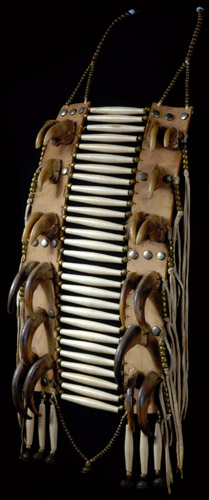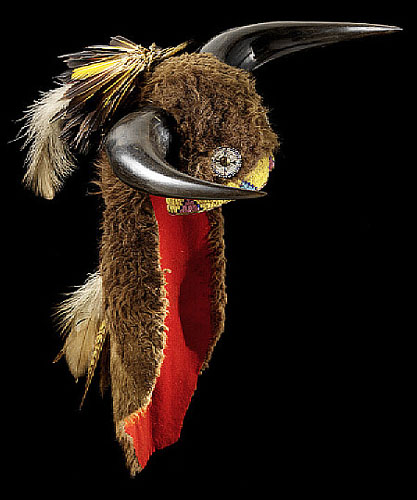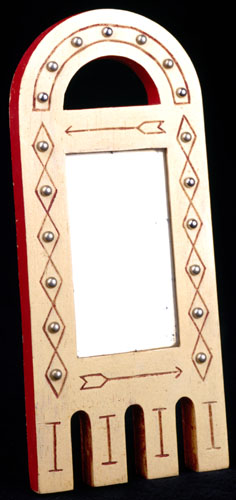|
Art
of the Osage, organized by the Saint Louis Art Museum, is the first
major exhibition to explore the art and culture of the American
Indian people known as the Osage. The exhibition also brings focus
to the vibrant story of the Osage, whose history traces to the great
Mississippian culture of North America. From the 17th to the 19th
century, the Osage inhabited the Upper Louisiana Territory amid
the Mississippi, Missouri, Osage, and Red Rivers, where their formidable
presence was significant in the country's westward expansion.
The
Saint Louis Art Museum presents Art of the Osage in a year celebrating
the bicentennials of the Louisiana Purchase and the Lewis and Clark
expedition as well as the centennial of the 1904 World's Fair in
St. Louis. The exhibition opens in the midst of the Three Flags
Festival commemorating the formal transfer of the Louisiana Territory,
which occurred in St. Louis on March 9-10, 1804. Representing the
Osage people at the event, Principal Chief of the Osage Nation James
Roan Gray will mark the seminal role of the Osage in the history
of the United States.
The
refined artistic tradition of the Osage reflects the sense of continuity
and purpose that has long united the Osage people in the values
of spirituality and community. Rich in meaning and complex in its
commitment to tradition and utility, Osage art is infused with aesthetic
vigor bound to exquisite simplicity.
Unlike
nomadic tribes, the Osage lived in permanent homes, cultivating
the bounty of the prairies, woodlands, and plains. For more than
a century before the Lewis and Clark expedition, the Osage controlled
nearly half of the region's fur trade. The dominance of the Osage
in this land of rivers, fiercely protecting its abundant natural
resources, was an important factor in the founding of St. Louis
in 1764. So significant was their influence that Meriwether Lewis
arranged for several Osage chiefs to travel to Washington in 1804
for an extended visit with President Thomas Jefferson. The Osage
homeland is now centered in the rich oil lands of Oklahoma, where
the last Osage reservation was established in 1872. There the Osage
continue to preserve the vitality of their artistic and cultural
traditions, while prospering in the business and political arena
of contemporary America.
The
"purposeful beauty" characteristic of the Osage aesthetic
is evident in the more than 100 objects featured in the exhibition.
The works of art come from public and private collections in the
United States and Europe and were selected according to the highest
aesthetic standards with the guidance and support of the Osage community.
Interpretive and contextual materials were developed in collaboration
with active Osage historians and artists. With objects spanning
250 years, the exhibition encompasses two major periods of Osage
art: the Old Era (1750-1900) and the New Era (1900 to the present).
Works
of art from the Old Era include objects created for child rearing,
hunting, domestic industry, and warfare. Highlighting the domestic
arts and child rearing are objects such as hand-carved cradle boards
decorated with brass bells and finger-woven straps, as well as dolls
dressed in high Osage fashion. The hunting arts are exemplified
by dramatic split-horn headdresses with trailing horse hair and
feathers. A group of boldly painted shields, riding quirts, and
war clubs illustrates the level of artistry dedicated to the accoutrements
of warfare. A particularly rare riding quirt depicting a warrior
with a bow and spear shows how quickly Osage artists adopted the
pictorial style of artists such as the notable Karl Bodmer, who
collected the quirt in 1834.
The
New Era is represented through the defining activities of the modern
Osage, including the In'Lon Schka dances, weddings, the War Mother's
Society, and the Native American Church. The arts of the New Era
reveal the strength of tribal identity in brilliantly colored and
patterned sashes, stunning beaded vests, feast bags, and silver
ornaments, all made for the In'Lon Schka dances. Plumed hats, ornate
military dress, and refined horse regalia represent the Osage wedding
arts. A particularly wonderful Osage wedding coat demonstrates how
Osage artists adapted western apparel using ribbon appliqué,
horse hair, and trade cloth to create elegant and masterful works
within the Osage aesthetic tradition. The War Mother's Society is
represented by a group of blankets with images of planes, tanks,
and flags that are woven, beaded, and sequined. The importance of
the native American Church is illustrated with fine examples of
sacred staffs, peyote fans, and rattles.
A
fully illustrated exhibition catalogue, published by the Saint Louis
Art Museum and the University of Washington Press, includes rare
black-and-white historical photographs dating from the 1870s as
well as excerpts from recorded interviews with members of the Osage
Nation. Catalogue contributors include exhibition curator John Nunley,
the Morton D. May Curator of the Arts of Africa, Oceania, and the
Americas at the Saint Louis Art Museum; Garrick Bailey, professor
of anthropology at the University of Tulsa; Daniel Swan, senior
curator of the Gilcrease Museum in Tulsa; and Sean StandingBear,
Osage oral historian and artist. Cultural reviewers for the catalogue
are Kathryn Red Corn, director of the Osage Tribal Museum, and Leonard
Maker, distinguished Osage elder. The project has been strongly
supported by Principal Chief of the Osage Nation James Roan Gray
and former Principal Chief Charles Tillman, Jr.
Through
August 8, 2004
Shoenberg Exhibition Galleries
General Admission: $10
Seniors & Students: $8
Children (ages 6-12): $6
Members & children under 6: Free Admission is free to all on
Ford Free Fridays. Each paid admission includes an audio tour. Audio
tours are available on Fridays for $3 and are free every day for
Members. For ticket information, please call (314) 655-5299.
Generous
support for the Art of the Osage exhibition and catalogue has been
provided by The Henry Luce Foundation, The Edward L. Bakewell Jr.
Fund, and The Aileen and Lyle Woodcock Fund for the Study of American
Art.
 |
Shield
1900
Approximate
Diameter: 24 in. (61 cm)
hide, feathers, cloth, metal, and pigment
Osage Tribal Museum
Warfare
The Osage went to war only after careful deliberation and
ritual preparation. The smoking of a sacred pipe symbolized
consensus among the clans, whose priests, chiefs, officers,
and warriors then selected the time and place to attack. Osage
war parties struck with lightning speed and delivered deadly
blows to their adversaries. This ensured that there would
be no chance for the enemy to regroup, and it communicated
to other tribes the dangers of encroaching on Osage territories
and resources.
Battles
often took place on horseback, when weapons included rifles
as well as bows and arrows. In hand-to-hand combat, warriors
used clubs with deadly blades. Osage warriors protected themselves
with shields that were imbued with sacred power and used riding
quirts to encourage their horses to full speed. They wore
ritual dress and applied black paint, representing death,
to their faces. Their red and black headdresses, known as
roaches, stood for the destructive nature of prairie fires
and the ashes left behind. The lone feather of a roach headdress
represented the Osage warrior who stood tall amid death and
destruction.
|
|
|
|
Cradleboard
1930-1940
11
x 12 x 40 1/2 in. (27.9 x 30.5 x 102.9 cm)
wood, brass, beads, brass bells, yarn, paint, and cloth
Gilcrease Museum, Tulsa, Oklahoma
Child
Rearing
The most valued people in Osage society are children. The
strong sense of order among Osage people traditionally has
resulted in strict rules concerning the rearing of children
according to gender and birth order. In previous generations,
firstborns of either gender were educated to become community
leaders, while their siblings were brought up to take service
roles.
Infants
were tended by their mothers, who kept them safe on cradleboards,
soothing them with the sound of bells and entertaining them
with dazzling beads and finger-woven pieces. As toddlers,
girls played with toy cradleboards and dolls that they learned
to dress in proper male and female attire. Boys played with
pull toys and model bows and arrows, which helped them prepare
for their adult roles. Young boys were ritually dressed at
dances to indicate their social development. In addition to
the child's parents, many relatives and clan members were
involved in the raising of children to help ensure the success
of the next generation.
|
 |
|
|
 |
Bear
Claw Breastplate
1900
Approximate:
18 x 10 in. (45.7 x 25.4 cm)
bone, bear claws, hide, and metal
Osage Tribal Museum
Domestic
Industry
Osage men and Osage women contributed to domestic industry.
Women were more concerned with everyday dress and accoutrements,
while men produced objects related to warfare and other sacred
rituals.
Hunters
supplied hides, bone, sinew thread, and fur to the women after
the bison hunts. Other materials for domestic industry were
secured from European fur traders who offered beads, trade
cloth, metal, paint, and silks in exchange for hides. Women
prepared the hides through a process known as brain tanning.
This was a technique in which brain matter from the animal
was spread on the stretched hide until it became soft and
supple. After this process, the women cut the hide into shapes
and sewed it into leggings, bags, and moccasins. Many items
were decorated with glass beads, wool, quillwork, and paint.
Items intended for ritual use, such as clan priest turbans,
incorporated materials considered sacred, including otter
fur, bird beaks, and feathers.
|
|
|
|
Bison
Headdress
1900
28
3/8 x 15 3/4 x 7 7/8 in. (72 x 40 x 20 cm)
bison hide, horn, feathers, beads, and brass
National Museum of the American Indian, Smithsonian Institution
Hunting
In the Old Era, hunting was necessary to provide food, fur,
and other commodities for use among the Osage and for export
to the world market. Hunting expeditions for bison were conducted
in late spring after squash, beans, and corn had been planted
and again in the early fall after the crops had been harvested.
The power and temperament of bison made the hunt a dangerous
enterprise, and competing tribes on the hunting grounds presented
additional dangers to the Osage.
There
were strict rules imposed for the hunt. A chain of command
determined who would strike first, who had rights to specific
animals, and how the various pieces of the animals were to
be distributed. Hunters on horseback frequently used short
bows to wound the bison, while hunters on foot used long bows
to deal the lethal blows.
While
little is known about the ritual preparations for hunting,
pictorial records indicate that men of other Indian tribes
wearing full bison dress and horned headdresses danced to
entreat the bison spirits to give of themselves and feed their
people.
|
 |
|
|
 |
Mirror
Board
1900
13
x 6 x 1 in. (33 x 15.2 x 2.5 cm)
wood, metal, paint, and glass
Osage Tribal Museum
E-Lon-Schka
The Osage have always understood dancing as a tradition that
unites the community and provides a sense of social identity.
As Osage leaders looked for new ways to celebrate Osage identity,
they became interested in the contemporary dances of their
sister tribes in the region. Two of those tribes-the Ka and
the Ponca-transferred their drums and dances, including the
E-Lon-schka, to the Osage people at the three Osage villages
of Gray Horse, Hominy, and Pawhuska. The E-Lon-schka dances
became central to Osage ritual and communal life. Today the
dances are held on three weekends in June, one at each of
the Osage villages.
The
E-Lon-schka dances take place on an earthen floor under an
arbor consisting of a large, corrugated roof without walls.
Singers gather around the drum at the center of the arbor.
Male dancers in traditional dress move counterclockwise around
the drum. Headdresses, leggings, tail pieces, vests, moccasins,
belts, silver body ornaments, and ribbon shirts constitute
typical dance suits. Later, the women and young girls enter
the arbor, dressed in skirts and blankets decorated with colorful
ribbonwork. Their subtle and stately movements are in strong
contrast to the animated and athletic dances of the men. The
Osage embrace the E-Lon-schka dances to solidify their community
and pass Osage traditions on to their children.
|
|
|
|
Wedding
Coat
20th century
42
x 61 in. (106.7 x 154.9 cm)
wool and silk
Denver Art Museum Collection, Native Arts Acquisition funds,
1963.157
Weddings
In the Old Era, weddings were arranged between clans of the
opposite sides of the tribe. For example, a bride from the
Sky people might be matched with a groom from the Earth people.
Today many Osage marry for romantic reasons, frequently outside
the tribe. Horses used to be the gift of choice for special
occasions and dowries, but fine Pendleton blankets and cash
are more popular today. Brides and their bridesmaids still
dress in military-style suits with ribbon appliqués,
finger-woven sashes, and ostrich-plumed hats. Many Osage couples
now prefer to be married wearing Western-style clothing and
in Christian churches. The children of Osage unions are taught
the Osage way which they, in turn, will adapt to changing
times.
|
 |
|
|
 |
War
Mothers Blanket
1900
77
3/4 x 59 in. (197.5 x 149.9 cm)
wool, cloth, and glass beads
Osage Tribal Museum
War
Mother's Societies
Following World War I, the Osage found a way to honor their
sons and daughters who had served in foreign wars. They developed
the War Mother's Societies, which sponsor Soldier Dances.
These events replace the old dances associated with warfare.
Soldier
Dances are held on the Saturday before Mother's Day and on
Veterans Day at the various VFW lodges in Osage County. The
ceremony begins as the flags are presented to those seated
at tables along the walls. This is followed by women dancing
to celebrate the bravery and commitment of their sons and
daughters. The dancers wear beautiful blankets decorated with
patriotic symbols and emblems. Names of soldiers and their
units may also be stitched or appliquéd on the blankets,
which are treasured by families in the community.
|
|
|
|
Gourd
Rattle
1900
25
x 3 x 3 in. (63.5 x 7.6 x 7.6 cm)
glass beads, copper, brass, bronze, gourd, protein combination,
and plastic
Department of Anthropology, Smithsonian Institution
Native
American Church
Toward the end of the nineteenth century, a new religion swept
through many American Indian societies. Known as the Native
American Church, it combines elements of Christianity with
many of the rituals and traditions of older Indian religions.
Osage elders adapted this religion to suit their own purposes.
Consistent with the Old Era religion, the new church was laid
out along the east-west path of the sun, with the door to
the church opening to the east.
Services
are held to celebrate the special occasions of life and to
soften the hardship of death. In ceremonies that begin at
sundown, men sit around a fire, talk, and sing songs to the
accompaniment of a drum. Women and children seated along the
church walls observe the service. Feather fans are used in
blessings. Gourd rattles with beautiful bead decorations,
drums, singing, and the crackling of a sacred fire at the
center of the church create a richness of sound. After the
meeting, members, relatives, and invited guests conclude the
service with a meal.
|
 |
|










